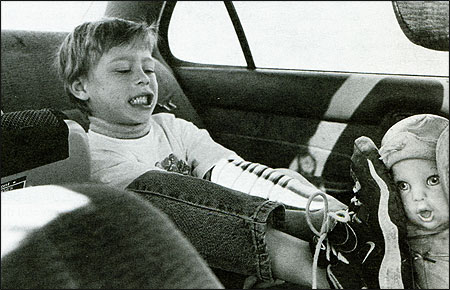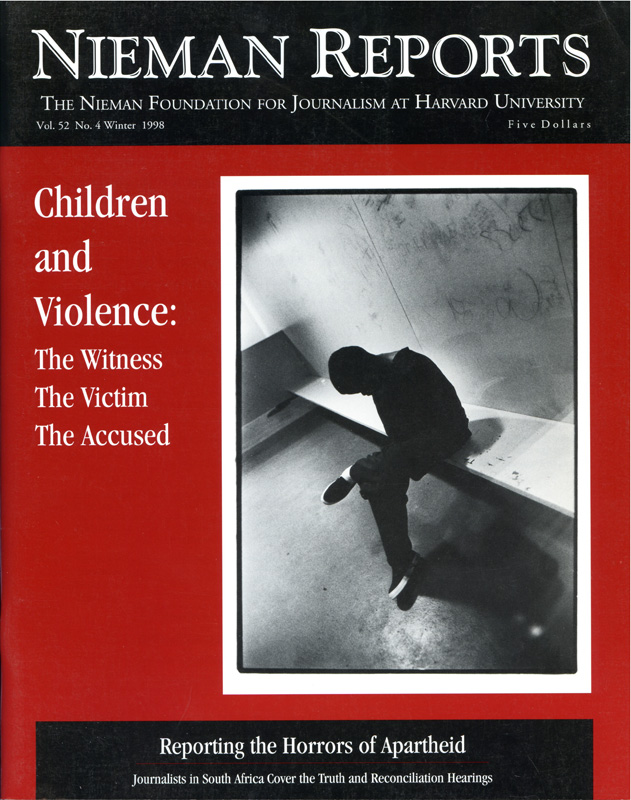
“I went to Vermont and showed Ernie this story, as it appeared in the magazine. I started from the back and showed him the last picture with his mom. She’s playing with him and he’s happy. I showed him some of the school pictures, and then we finished with this picture of him in the car attacking a doll and screaming. As I showed him the story, he had been very serious all along but when he saw this picture, he started to sort of half smile. Like he really didn’t know what to make of it. So we talked about it, and I said, ‘You really scared me when I saw you taking that doll and ripping it apart and the things that you were saying. That’s when I realized that you really needed help. And I want you to continue talking to people about what you feel inside.’ He accepted what I said and was quiet and then he went back to being with his friends and his mom. But there was a whole process to go through with that.”
—Donna Ferrato.
Photo © 1997 Donna Ferrato.
I kept checking the map. It kept saying this was Vermont. But this Vermont where I was reporting a story about children in a violent family had as little congruity with my Vermont—the one where I’d driven back roads and lived for a time—as the map did with the mud under my feet. I had never been in this place of fear before. The children whose story I was here to report called this terrifying territory home.
The girl of four and the boy of seven lived with their mother. Their father was in jail for attacking her, as he had throughout their short lives. When I began reporting their story, he was soon to be released. The family’s fear was contagious. Their aging mobile home was isolated and had only one electrical outlet. Photographer Donna Ferrato and I stayed overnight once in a while, because the children’s most extreme behavior occurred in the early morning. As we got ready to bed down on the convertible couch one evening, a car’s headlights blazed through the trailer’s window. The dog barked. We huddled on the couch with the family, thinking, “Is this him? Does he have a gun?” I finally went outside with a flashlight. It was a false alarm. But I, an adult, was scared. The children always lived with such stress.
My greatest fear was not that their father would kill me, but that in chronicling their lives, I would betray the children’s trust. They liked having us stay with them; it made them feel safer. They knew we were doing a story for a magazine, but they were too young to really understand what that meant. To them, we seemed more like family friends, one with a camera, one with a notebook. Because they were not media savvy, part of my job became protecting them from myself. I had to think constantly about how my story in print, with photographs of their faces, would affect their lives.
I call myself a documentary reporter. I don’t do interviews. I listen and watch. But journalists, no matter how quiet, change the dynamic simply by being present. A relationship with the subject develops, and the longer you stick around, the less professional it is likely to be. When I’m in my office I try to be objective, but I find it hard on the road to stand back and simply observe.
On this story, I couldn’t just watch for very long: I am a mother as well as a journalist. Because we were in the trailer so much, we bought food. I washed the kitchen floor; Donna folded the children’s mounds of clothing. When Ernie began beating on his sister, Donna separated them. When they began to trash a borrowed car, I stopped them. And those were the easy calls. After their father got out of prison, the children and their mother, frightened by rumors that he was looking for them, showed up at our motel in the middle of the night. Should we have turned them away in the interest of journalistic integrity? Or should we have let the tired, frightened children and their mother sack out in Donna’s room, while she moved into mine? I agonized every time I intervened but, in the end, I had to act from my heart.
Even though Donna and I wondered whether involving their father in our story would protect the children or expose them to greater danger, we visited him while he was still in prison. When we explained what we were working on, he stormed out of the visiting room. The next day we went back. We knew he could see us in the parking lot from his cell window, so we waited there to let him think about talking to us this time. Then we sent a note in with the guard saying we needed his side of the story. He agreed to meet with us and told us his life story. When he saw our Mother Jones article, angry as he was, he said that everyone in this country should read it.
If the children’s parents wanted the story to be told, the therapeutic community did not. We were met with hostility from caseworkers, counselors, psychologists and probation officers. Since the purpose of our story was not only to focus on an aspect of domestic violence that rarely receives media attention, but also to show what one model program, the Addison County Children Who Witness Violence Project, was doing to help these children heal, I was stunned. I had been counting on these people to help me interpret what I was seeing and put these children’s reactions in a broader context. Instead, I was presented with a formal list of concerns. Many of these I shared—protecting the children, confidentiality of therapeutic information, the dangers of quick in-and-out coverage. These days few media outlets are willing to pay for long-term coverage. But to do a story such as this one a reporter can’t just drop into a child’s life for a week and then leave, especially when there’s a history of untrustworthy adults left behind. In the end, I found ways to report this story off and on for a year.
Some of their concerns I found insulting, for instance that I had come with a hidden agenda. I could only assert the purity of my motives and the depth of my professional experience. But what I regarded as the most egregious “concern” was the service network’s belief that Ernie’s mother was incapable of making the decision to participate in a story she felt was important. When she realized this, she bristled at their arrogance and theorized that the reason they didn’t want her to cooperate was that they, too, were afraid of the children’s father.
In the end, the family court mediator and coordinator of the Children Who Witness Violence Project welcomed us. So did an organization called Women in Crisis, including the leaders of a battered women’s group and the counselors of a summer camp for children from violent families. The others never did help us or, I think, trust us. And now, sadly, even as experts from all over the nation want help setting up similar programs, the one in Vermont has collapsed due to lack of funding. Yet in part because of the program’s work, Ernie and his sister appear to be thriving. They are now living with their mother in a nicer trailer in town and visit their father in controlled situations. We just heard that Ernie got a perfect score on a spelling test. Ironically, too, our relationship with the family has outlasted that of the psychologists who predicted that we, the journalists, would hit-and-run.
Generally, I must write what the market demands, and today that seems to be unambiguous stories that display tensions, historic context, “color,” resolution—all wrapped up neatly with a clear beginning and a definite ending. But any story about a family’s life can only be a segment chopped out of the middle of a continuing saga. I don’t know how Ernie’s story is going to end, because it hasn’t ended. But perhaps the examination of a childhood shadowed by violence can inform our understanding of why, as they grow up, some such children strike out at others or turn their rage on themselves.
When I went out to Jonesboro, Arkansas and Springfield, Oregon, the sites of school shootings, my new awareness caused me to look for violent homes there, too. I never really found out what went on, possibly because violence is usually a family secret.
But make no mistake; we all live in the Vermont I couldn’t find on my map. That place of fear is in every one of the United States. It is the place where, without warning, loved ones—parents and mates and even children—can turn into monsters. The lessons from a few words and pictures are not easy ones to face, but they are important. Fear cripples. Every child counts. Every act has consequences. A slap at the wrong time can harm. A word at the right time can help. Children grow up. The slaps and the words will echo in the world we have to live in.
Claudia Glenn Dowling has been a staff writer at Life magazine for 15 years. A recent winner of the PASS Award from the National Council on Crime and Delinquency for “Women and Babies Behind Bars” (Life, September 1997), she has the greatest respect for the photographers with whom she has worked.



